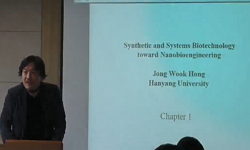So far, it is commonly accepted to establish a close relation between compounds and syntactic constructions. Especially in Korean not a few compounds correspond to syntactic constructions in the ordering of each constituents. As we know these compound...
http://chineseinput.net/에서 pinyin(병음)방식으로 중국어를 변환할 수 있습니다.
변환된 중국어를 복사하여 사용하시면 됩니다.
- 中文 을 입력하시려면 zhongwen을 입력하시고 space를누르시면됩니다.
- 北京 을 입력하시려면 beijing을 입력하시고 space를 누르시면 됩니다.
https://www.riss.kr/link?id=A77030514
- 저자
- 발행기관
- 학술지명
- 권호사항
-
발행연도
2006
-
작성언어
Korean
-
주제어
합성 ; 통사적 구성 ; 어순 ; 핵-끝머리 속성 ; compounding ; syntactic constructions ; ordering ; head-final property
-
등재정보
KCI등재
-
자료형태
학술저널
- 발행기관 URL
-
수록면
235-272(38쪽)
-
KCI 피인용횟수
18
- 제공처
- 소장기관
-
0
상세조회 -
0
다운로드
부가정보
다국어 초록 (Multilingual Abstract)
In fact those partial correspondences are caused by the principles such as head-final property in Korean which govern not only words (including derivatives and compounds) but also sentences. So it is not the case that the correspondences in ordering are resulted from the application of syntactic principles into words.
So far, it is commonly accepted to establish a close relation between compounds and syntactic constructions. Especially in Korean not a few compounds correspond to syntactic constructions in the ordering of each constituents. As we know these compounds are called ‘syntactic compounds’. But first of all these compounds have to be divided into two categories. One is compounds which have exactly the same constituent order and external shape as syntactic constructions. The other is compounds which have the same constituent order but not external shape as syntactic constructions. The former are recognized as ‘syntactic compounds’ which were formed through syntactic processes. But the latter cannot be regarded as such. Because there are many unsolved problems such as overgenerating, ellipsis of functional head, existence of roots and so forth. That is to say, it is not economical at all to form those compounds through syntactic processes.
In fact those partial correspondences are caused by the principles such as head-final property in Korean which govern not only words (including derivatives and compounds) but also sentences. So it is not the case that the correspondences in ordering are resulted from the application of syntactic principles into words.
목차 (Table of Contents)
- 1. 머리말
- 2. 어순과 관계되는 합성어 유형
- 3. ‘명사+명사’ 합성명사와 어순
- 4. 합성용언과 어순
- 5. 맺음말
- 1. 머리말
- 2. 어순과 관계되는 합성어 유형
- 3. ‘명사+명사’ 합성명사와 어순
- 4. 합성용언과 어순
- 5. 맺음말
- 참고문헌
- 영어 초록
참고문헌 (Reference)
1 송원용, "활용형의 단어 형성 참여 방식에 대한 연구" 서울대 1998
2 박진호, "형태론의 제자리 찾기-인접학문과의 관계를 중심으로" 1 (1): 319-340, 1999
3 전상범, "형태론" 한신문화사 1995
4 안상철, "형태론" 민음사 1998
5 김창섭, "현대국어의 복합동사 연구" 서울대 1981
6 송원용, "현대국어 임시어의 형태론" 3 (3): 1-16, 2000
7 연재훈, "한국어 ‘동사성명사 합성어(Verbal Noun Compound)’의 조어법과 의미 연구" 서울대 1986
8 이건환, "한·영·독·스페인어 명사구의 어순 비교 연구" 언어과학회 1 (1): 141-160, 2004
9 국립국어연구원, "표준국어대사전" 두산동아 1999
10 최형용, "파생어 형성과 빈칸" 40 (40): 619-636, 2004
1 송원용, "활용형의 단어 형성 참여 방식에 대한 연구" 서울대 1998
2 박진호, "형태론의 제자리 찾기-인접학문과의 관계를 중심으로" 1 (1): 319-340, 1999
3 전상범, "형태론" 한신문화사 1995
4 안상철, "형태론" 민음사 1998
5 김창섭, "현대국어의 복합동사 연구" 서울대 1981
6 송원용, "현대국어 임시어의 형태론" 3 (3): 1-16, 2000
7 연재훈, "한국어 ‘동사성명사 합성어(Verbal Noun Compound)’의 조어법과 의미 연구" 서울대 1986
8 이건환, "한·영·독·스페인어 명사구의 어순 비교 연구" 언어과학회 1 (1): 141-160, 2004
9 국립국어연구원, "표준국어대사전" 두산동아 1999
10 최형용, "파생어 형성과 빈칸" 40 (40): 619-636, 2004
11 박진호, "통사적 결합 관계와 논항구조" 서울대 1994
12 이선희, "통사부의 핵이동에 대하여" (1) : 237-263, 1994
13 장윤희, "중세국어 비통사적 합성동사와 관련된 몇 문제(이병근선생퇴임기념 국어학논총)" 623-641, 2006
14 채현식, "조어론의 규칙과 표시" 1 (1): 25-42, 1999
15 연재훈, "이른바 ‘고기잡이’류 통합합성어의 단어형성에 대한 문제" 3 (3): 333-343, 2001
16 채현식, "유추에 의한 복합명사 형성 연구" 서울대학교 2000
17 최현배, "우리말본(다섯번째 고침)" 정음사 1937
18 한글학회, "우리말 큰사전" 어문각
19 최형용, "어근과 어기에 대하여" 4 (4): 301-318, 2002
20 임홍빈, "사이시옷 문제의 해결을 위하여" 국어학회 (10) : 1-35, 1981
21 최상진, "복합명사 어순에 있어서의 공감도 연구" (11) : 53-69, 1992
22 채완, "병렬의 어순과 사고방식" 국어학회 (14) : 463-477, 1985
23 왕문용, "명사 관형구성에 대한 고찰" (4) : 139-157, 1989
24 시정곤, "규칙은 과연 필요 없는가?" 1 (1): 261-283, 1999
25 고영근, "국어형태론연구" 서울대학교 출판부 1989
26 송철의, "국어의 파생어형성 연구" 태학사 1992
27 임홍빈, "국어의 재귀사 연구" 신구문화사 1987
28 이남순, "국어의 부정격과 격표지 생략" 탑출판사 1988
29 김창섭, "국어의 단어형성과 단어구조 연구" 태학사 1996
30 최형용, "국어의 단어 구조에 대하여" 1 (1): 245-260, 1999
31 임지룡, "국어에 내재한 도상성의 양상과 의미 특성" 한글학회 (266) : 169-205, 2004
32 이기문, "국어사개설(개정판)" 탑출판사 1972
33 이익섭, "국어문법론강의" 학연사 1999
34 임홍빈, "국어문법론 Ⅰ" 한국방송통신대학교 출판부 1995
35 채현식, "국어 어휘부의 등재소에 관한 연구" 서울대학교 1994
36 심재기, "국어 어휘론 신강" 태학사 2000
37 채완, "국어 어순의 연구" 탑출판사 1986
38 채완, "국어 어순의 기능적 고찰" (20) : 103-119, 1990
39 성기철, "국어 어순 연구" 한글학회 (218) : 101-138, 1992
40 김승렬, "국어 어순 연구" 한신문화사 1988
41 권용경, "국어 사이시옷에 대한 통시적 연구" 서울대 2001
42 이선웅, "국어 명사의 논항구조 연구" 월인 2005
43 임홍빈, "국어 명사구와 조사구의 통사 구조에 대하여" (24) : 1-62, 1999
44 최경봉, "국어 명사 관형구성의 의미결합 관계에 대한 고찰" 국어학회 (26) : 33-58, 1995
46 시정곤, "국어 단어형성의 원리(수정판)" 한국문화사 1998
47 최형용, "국어 단어의 형태와 통사" 태학사 2003
48 임홍빈, "국어 굴절의 원리적 성격과 재구조화-‘교착소’와 ‘교착법’의 설정을 제안하며" (22) : 93-163, 1997
49 김봉모, "국어 ‘N1-N2’ 구조 연구(새결박태권선생회갑기념논총)" 443-459, 1984
50 이남순, "격표지의 비실현과 생략" 국어학회 (31) : 339-360, 1998
51 최형용, "격조사의 핵성에 대하여(우리말 연구 서른아홉 마당-임홍빈선생회갑기념논총)" 401-418, 2004
52 한정한, "격조사는 핵이 아니다" 한글학회 260 : 149-182, 2003
53 임홍빈, "가변 중간 투사론-표면구조 통사론을 위한 제언" 127-147, 1999
54 최형용, "‘줄임말’과 통사적 결합어" 국어국문학회 135 : 2003
55 최형용, "‘술래잡기’에 대하여(이병근선생퇴임기념 국어학논총)" 1019-1033, 2006
56 시정곤, "‘X를 하다’와 ‘X하다’의 상관성" 국어학회 (24) : 231-258, 1994
57 Plag. I, "Word-Formation in English" Cambridge: Cambridge University Press 2003
58 Hawkins. J. A, "Word Order Universals" New York: Academic Press 1983
59 Aronoff. M, "Word Formation in Generative Grammar" Cambridge: MIT Press 1976
60 Greenberg. J. H, "Universals of Language" Cambridge: MIT Press 1966
61 Haspelmath. M, "Understanding Morphology" London: Arnold 2002
62 Lees. R, "The Grammar of English Nominalization" Hague: Mouton 1960
63 Chomsky. N, "Remarks on Nominalization, In Readings in English Transformational Grammar" Ginn and Company 184-221, 1970
64 Jang, Yong-Seon, "On constraining incorporation in Korean word formation" Australia: Griffith University 1996
65 Aronoff. M, "Morphology by Itself" Cambridge: MIT Press 1994
66 Aronoff. M, "Morphology and the lexicon: lexicalization and productivity(The Handbook of morphology)" Oxford: Blackwell 237-247, 1998
67 Spencer. A, "Morphological Theory" Oxford: Blackwell 1991
68 Bloomfield. L, "Language" New York: Holt 1933
69 Baker, M. C, "Incorporation : A Theory of Grammatical Function Changing" Chicago: University of Chicago Press 1988
70 Scalise. S, "Generative Morphology" Dordrecht: Foris 1984
71 Bauer, L, "Compounding" Berlin: Walter de Gruyter 1 : 695-707, 2001
72 Tomlin. R. S, "Basic Word Order" Croom Helm: Kent 1986
동일학술지(권/호) 다른 논문
-
- 국어국문학회
- 김미영(Kim Mee-Young)
- 2006
- KCI등재
-
- 국어국문학회
- 박진호(Park Jin-Ho)
- 2006
- KCI등재
-
- 국어국문학회
- 김동건(Kim Dong-Keon)
- 2006
- KCI등재
-
- 국어국문학회
- 신광철(Shin Kwang-Cheol)
- 2006
- KCI등재
분석정보
인용정보 인용지수 설명보기
학술지 이력
| 연월일 | 이력구분 | 이력상세 | 등재구분 |
|---|---|---|---|
| 2020 | 평가예정 | 계속평가 신청대상 (등재유지) | |
| 2015-01-01 | 평가 | 우수등재학술지 선정 (계속평가) | |
| 2011-01-01 | 평가 | 등재학술지 유지 (등재유지) |  |
| 2009-01-01 | 평가 | 등재학술지 유지 (등재유지) |  |
| 2007-01-01 | 평가 | 등재학술지 유지 (등재유지) |  |
| 2004-01-01 | 평가 | 등재학술지 선정 (등재후보2차) |  |
| 2003-01-01 | 평가 | 등재후보 1차 PASS (등재후보1차) |  |
| 2002-01-01 | 평가 | 등재후보학술지 유지 (등재후보1차) |  |
| 1998-07-01 | 평가 | 등재후보학술지 선정 (신규평가) |  |
학술지 인용정보
| 기준연도 | WOS-KCI 통합IF(2년) | KCIF(2년) | KCIF(3년) |
|---|---|---|---|
| 2016 | 0.79 | 0.79 | 0.75 |
| KCIF(4년) | KCIF(5년) | 중심성지수(3년) | 즉시성지수 |
| 0.72 | 0.72 | 1.376 | 0.3 |




 DBpia
DBpia







